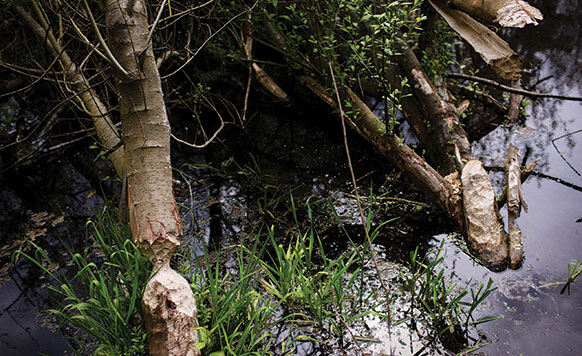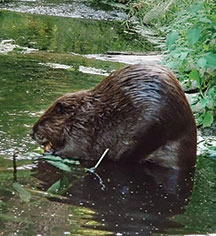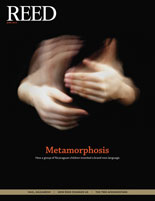
IRIS login | Reed College home Volume 92, No. 2: June 2013
Eliot Circular
Bucktooth Engineers Reshape Canyon

Industrious beavers have dammed sections of the canyon, flooding invasive bunchgrass. Photo by Leah Nash
By Miles Bryan ’13

Photo by Zac Perry
Reed canyon is under construction. Trees are being felled, dams built, and new areas flooded. These represent some of the most significant changes to the canyon since its restoration in the late ’90s, and they are the work of a masterful colony of engineers. Yes, we’re talking about beavers.
Like many other native species, beavers are increasingly returning to the canyon, drawn by Reed’s herculean efforts to restore the area to its native state. This spring, roughly a dozen of them have been demonstrating their species’ legendary industry. They have downed scores of trees to create a series of dams and ponds, slowing the flow of Reed Lake, and raising the water level by as much as six feet.
“The beavers are doing what we couldn’t,” says canyon restoration specialist Zac Perry. “They’re reshaping the canyon.”
Ironically, Perry has long wished for many of these changes, but was hamstrung by state and local regulations. The canyon is a designated wilderness area, intended as a haven for Oregon’s native ecosystems to thrive. But that designation also limits human meddling. For example, Perry cannot divert water from the lake, slow the creek down, or build dams without enduring lengthy state and federal permitting processes.
The beavers, however, have made short work of the bureaucratic niceties. Their dams have flooded areas which had been overrun by invasive bunchgrass, a rhizomatous perennial which had fiercely resisted all human efforts at control. In addition, they’ve been eagerly chewing away at invasive trees—such as wild plum and sycamore maple—that have taken root on the canyon’s banks. (They generally seem to find native trees unappetizing.)
Canyon crews of yore did not always take so kindly to the chiseling critters. For decades, Reed treated the canyon as a kind of glorified park. The lake was diked in 1929 to make space for the outdoor swimming pool, woody debris was burned because it was considered ugly, and bags of concrete served as stepping stones through the marsh shallows.
In those years beavers were seen as a menace. That began to change when Perry arrived in 1999 to lead Reed’s initiative to restore the canyon. Perry and his canyon crews have reintroduced scores of native plants, and their hard work has attracted several sentinel species, including otters, herons, steelhead trout, and coyotes. Maintaining wilderness in an urban setting is a never-ending task, however—so the crews welcome all the help they can get.

LATEST COMMENTS
steve-jobs-1976 I knew Steve Jobs when he was on the second floor of Quincy. (Fall...
Utnapishtim - 2 weeks ago
Prof. Mason Drukman [political science 1964–70] This is gold, pure gold. God bless, Prof. Drukman.
puredog - 1 month ago
virginia-davis-1965 Such a good friend & compatriot in the day of Satyricon...
czarchasm - 4 months ago
John Peara Baba 1990 John died of a broken heart from losing his mom and then his...
kodachrome - 7 months ago
Carol Sawyer 1962 Who wrote this obit? I'm writing something about Carol Sawyer...
MsLaurie Pepper - 8 months ago
William W. Wissman MAT 1969 ...and THREE sisters. Sabra, the oldest, Mary, the middle, and...
riclf - 10 months ago